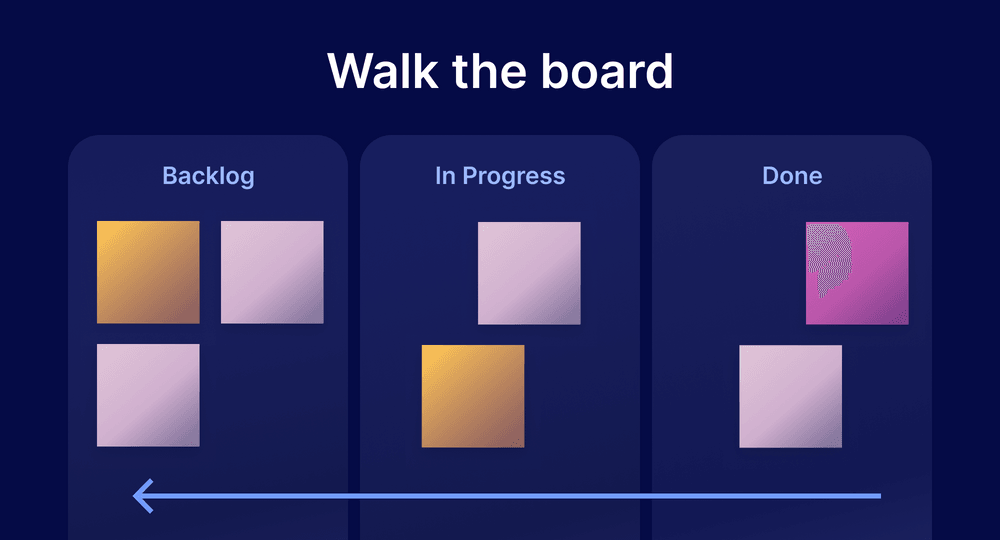
Are daily stand-ups a waste of time?

If your daily stand-ups feel like a waste of time, they probably are. Here’s what’s wrong with most stand-ups — and what you can do about it.
Here’s what’s wrong with daily stand-ups
It certainly may feel like a waste of time listening to how George attended the opening of an envelope yesterday, what it was like, and whether he’s planning on going to the same event today. Next up, it’s Suzy’s turn. She’ll make excuses for why she didn’t have time to work on Jira issue DEV-123. And then Peppa will give her status update: she completed DEV-111, started working on DES-122 and DEV-110. At this point, half the people have zoned out and are just waiting for each team member to finish their updates so they can get back to work.
Most daily stand-ups revolve around the idea that developers have to justify their usefulness to the company. And if they fail to complete a task, they’re expected to come up with an excuse. While you might get some value out of meetings like that, you’d probably agree that you should be getting more. After all, you’re wasting hours every week in those meetings.
How did we end up having daily stand-ups anyway?
The practice of daily stand-ups derives from the Scrum methodology. As surprising as it may be, the Scrum Guide doesn’t describe how you should conduct the meeting. Even more surprisingly, it doesn’t state that you should go around the room asking every developer the three classic questions:
- What did you do yesterday?
- What are you doing today?
- Are there any blockers?
The Scrum Guide focuses on the purpose and goal of the daily meetings.
The purpose of the Daily Scrum is to inspect progress toward the Sprint Goal and adapt the Sprint Backlog as necessary, adjusting the upcoming planned work.
In other words, the focus should be on a) making progress toward the team’s goal and b) coming up with an actionable plan for the day. It’s worth highlighting that the daily stand-up was never intended to become a status meeting. Somehow, though, we ended up with one anyway and act surprised when people say they don't find their stand-ups useful.
Ultimately, though, the problem isn’t that we run daily stand-ups. It’s how we run them. And luckily, that’s something you can change.
Introducing a better way to run your daily stand-ups: walk the board
Here at Swarmia, we’ve adopted the so-called “walk the board” method for running our daily stand-ups. As Kanban's service delivery principles suggest, it focuses on managing the work — not the people.
Here’s what walking the board entails in practice:
- Look at the board that shows the current status of every item
- Review each item in progress one by one
- Start from the items that are closest to being finished and walk towards the items that have just been started
- If you have multiple swim lanes, arrange lanes in the order of priority and start from the highest priority lane walking towards the lower priority lanes

Instead of focusing on what George did or will do today, walking the board allows you to focus on what you, as a team, can finish today. To make the meeting even more productive, you can ask questions like: “How can we finish this story today?”
This is especially beneficial if some of your team members are spending too much time on personal pet projects or fine-tuning trivial details. Walking the board helps the team focus on their goals. If the work isn’t visible on the board, it doesn’t deserve the team’s time or attention. And if the work is important and aligned with the team’s goal, it should be added to the board.
In addition to shifting the focus away from individuals to the value being created, walking the board also encourages collaboration in a way personal status updates can’t. I’ve also found these types of daily stand-ups easier to follow, digest, and manage.
Our daily stand-ups are broken, what can we do to fix them?
If you feel like your daily stand-up routine is broken, there’s a high likelihood your teammates feel the same. The best way forward is to bring up the issue in your next retrospective. You can discuss the goal and purpose of your daily stand-ups are, and brainstorm better alternatives for the meeting format.
Here are some common problems and possible solutions.
Our daily stand-ups are too long
Remember when I said the Scrum Guide doesn’t prescribe how you should conduct your daily stand-ups? Well, I lied. But I promise that the only thing it does prescribe is the length of the meeting. The guide says a daily stand-up should last no longer than 15 minutes.
It’s a good practice to keep the meetings short. The longer they get, the more likely people will find them irrelevant and zone out. Your facilitator should catch the topics that warrant longer conversations and move those for after the stand-up. This way, the stand-up itself will only take 15 minutes, and important conversation can continue after the daily — usually in smaller groups. After all, the whole team is rarely needed for these detailed conversations about a particular issue.
The daily stand-up is a good way to keep everyone in the loop about the work what’s happening in the team. It also gives the team an opportunity to flag any potential issues that need further planning or clarification. It’s a great way to get people together, share context, and start deeper conversations.
But remember, it’s not a status meeting, and your teammates don’t need to know everything.
The topics we discuss are irrelevant
Sometimes developers find the topics discussed in daily stand-ups irrelevant. If you go through tickets that you know nothing about, you haven’t been planning them, you haven’t worked on that corner of the codebase, and won’t be contributing to the work in the future, it’s no wonder you might have a hard time focusing.
The daily stand-up is unlikely to be the root cause here. Instead, it sounds like you’re not really working as a team. It’s surprisingly common for “teams” to consist of groups of individuals who work solely on their own user stories/features/corners of the codebase.
In other words, your real problem isn’t the stand-up; it’s that the work is siloed. You may want to spark the conversation and ask your team whether you really are a team. Should you all have the same single goal and break the silos? It may be wise to split the team, regroup, or refocus. And while I can’t give you any definitive answers here, I will say that skipping the daily stand-up and ignoring the issue is unlikely to make things better.
Our work doesn’t progress enough to warrant a daily meeting
If there isn’t any progress from day to day, walking the board every day may definitely feel like a waste of time. This is usually a sign of your stories or tasks being too large. On average, your tasks should be small enough to be completed in a day or two. Any task can be split, and you can split them even when they are in progress. Small tasks help team achieve faster results and gain feedback as early as possible.
TL;DR
Done right, daily stand-ups aren’t a waste of time. But to get the most value out of them, you need to stop blindly following some age-old best practices and make sure the format of the meeting supports the goals you’ve set as a team.
After all, the daily stand-up isn’t a status meeting. It’s an opportunity for your team to come together to plan how to move important work forward. So feel free to boldly try new formats and shake things up to see what works best.

Subscribe to our newsletter
Get the latest product updates and #goodreads delivered to your inbox once a month.
More content from Swarmia


